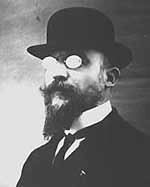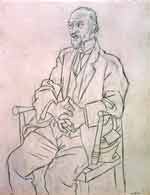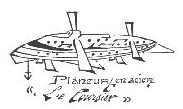
"I have never written
a note I didn't mean." - Erik Satie
You've heard his work in movies, commercials, even on "Sesame Street." He was the quintessential "artist's artist," a man who, as one critic wrote, "had the no-doubt gratifying sensation of seeing the times catch up with him." Erik Alfred Leslie Satie was born in 1866, and was raised in Paris during an age in which the Wagnerian music model reached its zenith in Europe. He began music lessons at the age of 15, but without much success - though some thought he had talent and potential, his playing was at various times called "insignificant and laborious" and Satie the student, "worthless." In the 1890s he joined the Rosicrucian church, and was introduced to the mystical strains of Gregorian and plainsong chant that would permeate his music for the rest of his life. Satie quickly became bored by the Rosicrucians, though, and decided to create his own church, which he called "L'Eglise Métropolitaine d'Art de Jésus Conducteur." For this he published an "official" manifesto that functioned primarily as soapbox upon which to rant against music critics.
Satie supported his one-member church by playing in the famous cabaret, the Chat Noir, where he met a young composer named Claude Debussy. Satie held strong influence over Debussy, instructing him to avoid all popular Wagnerian influences of the time. As he claimed, "There is no need for the orchestra to grimace when a character comes on stage. . . . What we have to do is create musical scenery . . . in which the characters move and talk." Debussy and friend Maurice Ravel began writing Satie-inspired pared-down music that eventually morphed French Impressionism. Debussy and Ravel only acknowledged Satie's influence many years later, as firmly established composers. But, while Impressionism flourished, Satie stayed in the cabarets, and stayed very poor, even called Monsieur le Pauvre by his friends. By the turn of the century he moved to a cheap industrial suburb of Paris, where he would spend the rest of his life, walking several miles each day to play at the cabarets and back home every night with hammer in his pocket for protection.
It was around this time that Satie began wearing his trademark gray velvet suits, earning himself the nickname "the velvet gentleman." He detested the sun, and tried to go outside only during bleak days. He washed only with pumice stone, never soap, but perhaps his most extreme behaviors centered around food: he "never spoke while eating, for fear of strangling himself," and only ate white foods. His list? Eggs, sugar, shredded bones, animal fat, salt, coconuts, rice, turnips, pastry, cheese (white varieties), cotton salad, and certain kinds of fish. In 1905, at the age of 40, Satie enrolled again in the conservatory to learn the "proper" classical techniques of counterpoint and theory. Surrounded by students half his age, he honed his skills and graduated top of class. With the classical training however, his music continued to become more bizarre. He began scribbling mysterious directions all over his
Spring of 1917 marked the premiere of the ballet Parade, a synthesis between literature and music, visual art and dance, fashion and poetry. For many, it was a long-awaited unification of art with everyday life, and an overdue break with the stifling bindings of Wagnerian late-romanticism.
The collaboration of poet, artist, and enfant terrible Jean Cocteau with the 48-year-old Satie began some three years prior, when the two had met as witnesses in a wedding. The charming Cocteau had attached himself to the Ballet Russes, becoming, in one critic's words Diaghilev's "court jester" and "house pixie." While artists championed Parade, critics panned it, and the piece outraged so many people that there was a riot the first night it opened. Satie, Cocteau, and a few of their cronies even found themselves facing a libel suit in court, culminating being labeled "cultural anarchists," and eight days of jail time for Satie. Cocteau and Satie thrived on scandal however, and Parade became something of a cult object. Thanks to the high standing of Diaghilev and Picasso (not to mention a scathing press) Satie became something of a celebrity. Shortly after the premiere Satie's newfound popularity found him at the center of a group of composers that would become known as Les Six. Satie collaborated with Les Six for the next several years and continued his interest in ballets, culminating in the 1924 premiere of Relâche.
Four decades of bourbon and absinthe had caught up with the composer however, and shortly after this event Satie became ill with cirrhosis of the liver and died. Though largely forgotten in the years following his death in 1925, during the 1960s Satie's music began to surface as an anecdote to more traditional classical music, and has risen in popularity ever since.
Erik Satie Homepage: the most complete Satie resource on the Web, featuring audio clips, manuscripts and articles, pictures, and a newsgroup discussion. Erik Satie's Furniture Music: "Satie created Musique d'ameublement (Furniture Music) as music that was not to be listened to, and to distinguish background music from 'serious' music," begins the worthwhile article on this site. SatieMart: An exhaustive collection of Satie recordings, most accompanied by reviews. Flabby Preludes for a Dog: An Erik Satie Primer: This essay by a New Jersey disc jockey offers an overview of Satie's career, focusing primarily on his musical influence. Satie's Vexations: This scholarly tract dissects Satie's composition Vexations - only 180 notes long, but directed to be repeated 840 times! John Cage organized the first recording of it in 1963 in New York, taking a relay team of 10 pianists more than 18 hours to perform. Cocteau's World: A comprehensive and professional site featuring articles, audio, links, and a biography of Satie's mentor.
Springtime
in Paris Home - Les Six - Erik
Satie - Online Audio
Art of the Time - Ballet, Literature & Film - Program Playlist
|
MPR Home | News | Music Collection | Events | Radio Listening | Your Voice | About Us | Support Us | Help ©2005 Minnesota Public Radio | Terms of Use | Privacy Policy |


